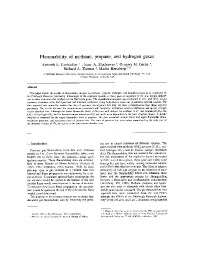Mining Publication: Flammability of Methane, Propane, and Hydrogen Gases
Original creation date: May 2000
Authors: KL Cashdollar, IA Zlochower, GM Green, RA Thomas, M Hertzberg
NIOSHTIC2 Number: 20020626
J Loss Prev Process Ind 2000 May 13(3-5):327-340
This paper reports the results of flammability studies for methane, propane, hydrogen, and deuterium gases in air conducted by the Pittsburgh Research Laboratory. Knowledge of the explosion hazards of these gases is important to the coal mining industry and to other industries that produce or use flammable gases. The experimental research was conducted in 20 L and 120 L closed explosion chambers under both quiescent and turbulent conditions, using both electric spark and pyrotechnic ignition sources. The data reported here generally confirm the data of previous investigators, but they are more comprehensive than those reported previously. The results illustrate the complications associated with buoyancy, turbulence, selective diffusion, and ignitor strength versus chamber size. Although the lower flammable limits (LFLs) are well defined for methane (CH4) and propane (C3Hg), the LFLs for hydrogen (H2) and its heavier isotope deuterium (D2) are much more dependent on the limit criterion chosen. A similar behavior is observed for the upper flammable limit of propane. The data presented include lower and upper flammable limits, maximum pressures, and maximum rates of pressure rise. The rates of pressure rise, even when normalized by the cube root of the chamber volume (V l/3), are shown to be sensitive to chamber size.

NIOSHTIC2 Number: 20020626
J Loss Prev Process Ind 2000 May 13(3-5):327-340
- Degasification System Selection for U.S. Longwall Mines Using an Expert Classification System
- Development and Application of Reservoir Models and Artificial Neural Networks for Optimizing Ventilation Air Requirements in Development Mining of Coal Seams
- Drainage of Methane From the Overlying Pocahontas No. 4 Coalbed From Workings in the Pocahontas No. 3 Coalbed
- Flammability of Gas Mixtures Containing Volatile Organic Compounds and Hydrogen
- Guidelines for the Control and Monitoring of Methane Gas on Continuous Mining Operations
- The Limiting Oxygen Concentration and Flammability Limits of Gases and Gas Mixtures
- Modeling and Prediction of Ventilation Methane Emissions of U.S. Longwall Mines Using Supervised Artificial Neural Networks
- Remote Methane Sensors
- Reservoir Rock Properties of Coal Measure Strata of the Lower Monongahela Group, Greene County (Southwestern Pennsylvania), from Methane Control and Production Perspectives
- Stochastic Modeling of Gob Gas Venthole Production Performances in Active and Completed Longwall Panels of Coal Mines